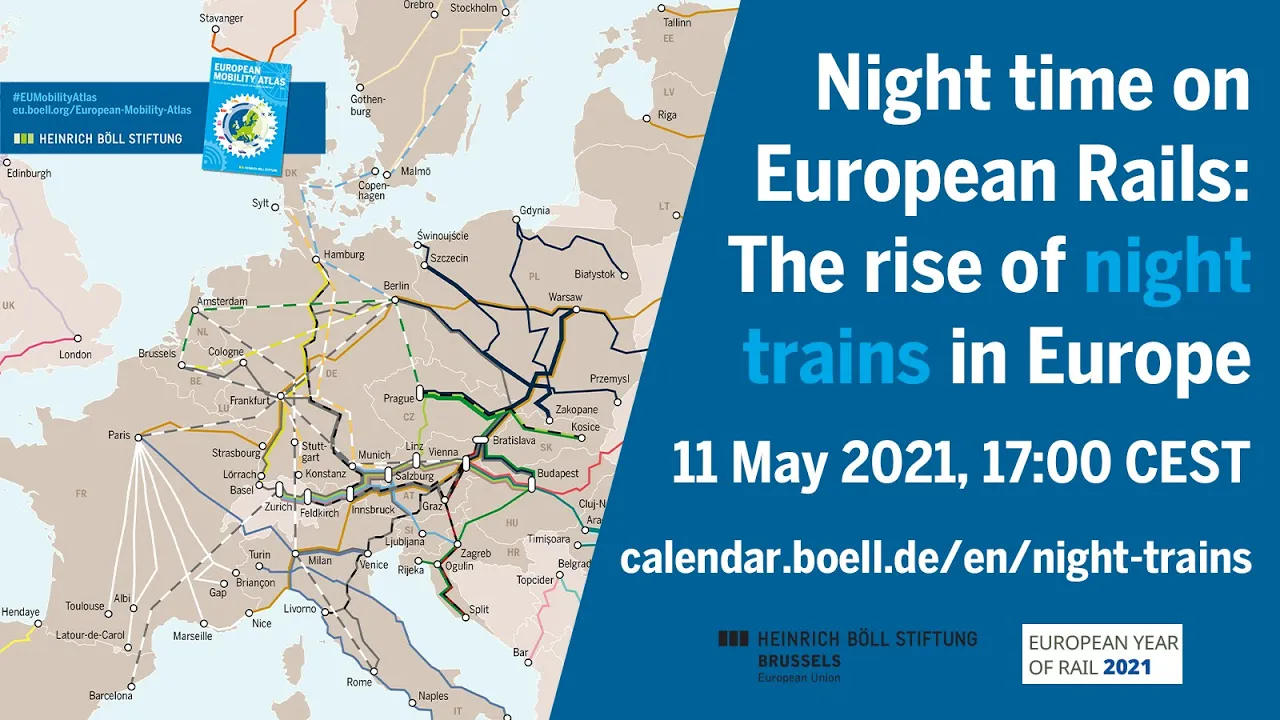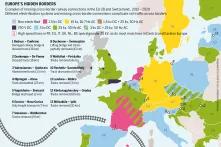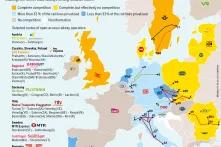Night trains are on the rise again. While Europe was widely interconnected by night trains until the end of the 20th century, connections decreased dramatically in the past two decades. This year, 2021, marks the European Year of Rail and the resurrection of important new night train connections, combined with fresh railway market entrants. Read on to learn more about this promising means of transportation.

The climate crisis and the Covid-19 pandemic have made us question and rethink our travel habits. Night trains are a good example of how to favour a more sustainable means of mobility. Because of the pandemic, rail connections, including night trains, were interrupted; now, just before the summer break, night train operators are relaunching those connections that had to be cut short.
There are more challenges to cross-border night trains than border closures, such as different legal requirements across EU member states, different signalling and electrification systems, and different track and loading gauges. Moreover, as with all railway undertakings, night trains face the payment of track access charges, which is an important disadvantage in the competition with flights.
Night trains are among the most sustainable and relaxing modes of transport to cover long distances in Europe; however, they are not yet the most common choice for everybody.
This article describes their main features by answering questions that arose during the Heinrich-Böll-Stiftung event “Night Time on European Rails: The rise of night trains in Europe”. The answers were provided by MEP Anna Deparnay-Grunenberg (Greens/EFA Group, rapporteur for the European Year of Rail 2021), Mark Smith (Founder, The Man in Seat 61), Veronika Haunold (EU and International Affairs Manager, Austrian Federal Railways - ÖBB) and Carl Adam Holmberg (Head of the open access railway company Snälltåget).
- What is the optimum frequency and regularity of overnight services, and how do you assess the demand for night train connections that do not exist yet?
- If you use a day train to connect to a night train of a different operator, will the responsibility be yours or be on the operators to look after you if you miss your connection?
- What makes the rolling stock for night trains so particularly scarce? What do you think about the EU-level night train rolling stock pool idea?
- Is a night train from London to Europe ever possible? Or is Brussels the future hub for travellers from the UK?
- What innovations in night train services can we expect in the next years?
- Will Snälltåget be able to run the Stockholm to Berlin connection all year round every night without any subsidy? Would you refuse a subsidy to run the line all year, if it was offered to you?
- Will the tax benefits of flight operators (fuel and VAT) be cut?
- Is it necessary for politicians to intervene in the markets to ensure that the night train is a viable alternative to the wide range of budget airlines on the market?
- What needs to be done to create fair competition between service night trains and other modes of transport?
- Are European laws being considered, incentivising EU countries to make infrastructure available for night trains?
1. What is the optimum frequency and regularity of overnight services, and how do you assess the demand for night train connections that do not exist yet?
Mark Smith (Seat61): Clearly, a daily service is ideal for most night sleeper connections. It is easy enough to look at overall demand for travel between two major cities by all modes. If there is a large overall market and the distance/journey time is suitable for a night train, such a train ought to be feasible.
Veronika Haunold (ÖBB): To offer as many night train connections as possible, a well-developed infrastructure is crucial. In addition, we need to distribute better rail capacities to enable cross-border trains and reliable connections with short waiting times. What is needed is a timetable that is coordinated throughout Europe. Only in this way, can we create optimal transfer connections and integrate night trains that are not part of the interval timetable.
The demand can be estimated based on a potential analysis, considering the source and target market, travel time, and the competitive situation with other modes of transport.
Carl Adam Holmberg (Snälltåget): It is difficult to say. It depends on the route and its specific market situation. There is no ideal frequency relevant on all routes.
2. If you use a day train to connect to a night train of a different operator, will the responsibility be yours or be on the operators to look after you if you miss your connection?
Veronika Haunold (ÖBB): There is an agreement with DB Fernverkehr (a division of Deutsche Bahn that operates long-distance passenger trains in Germany) to share the risk between ÖBB and DB. In all other countries (except Belgium), the Nightjet trains are operated by the national railway companies, which are also commercially responsible — therefore, the risk of connection loss is also with these railways.
Carl Adam Holmberg (Snälltåget): The operator that provides a connection to another train is responsible for the onward journey if the reservation is made all the way at once. This is comparable to what we see in other modes of transport, e.g. air travel.
3.What makes the rolling stock for night trains so particularly scarce? What do you think about the EU-level night train rolling stock pool idea?
Veronika Haunold (ÖBB): European Railway Undertakings (RUs) have access to a wide range of institutional lenders, specialized in railway rolling stock financing — such as EIB, EBRD, KfW or EUROFIMA. In addition, RUs can always refer to institutional investors and use the commercial banking sector. Sometimes the vehicle manufacturers themselves — also through specialized subsidiaries — offer RUs very interesting financing conditions, where appropriate in combination with maintenance issues. Since there are a variety of financing options for rolling stock open to European RUs, ÖBB sees no need for additional (legal) initiatives (such as the introduction of a rolling stock pool). Increased investment needs should be covered through dedicated existing European funding instruments (e.g. CEF) for the upgrading of rolling stock with multi-system technology for international use.
Carl Adam Holmberg (Snälltåget): There is a shortage of rolling stock today in Europe and that is, of course, a problem for operators like us who want to develop new night train services. This shortage is because only a few new night train coaches have been built in the past years and that some operators prefer to destroy their old rolling stock rather than selling it to new entrants that could refurbish them and give them a second life. One possibility to solve this problem could be an EU-supported rolling stock pool for all operators. Another way forward would be to force all operators to offer excess rolling stock they do not want to use anymore to other operators (incumbents and new entrants).
Mark Smith (Seat 61): If you wanted to start an airline, leasing planes is a well-developed market. Leasing trains is not, and leasing stock for night trains certainly is not. Often, operators abandoned night trains as their stock became life-expired, avoiding the need to replace it. Other operators abandoned night trains and scrapped the stock or let it rot in sidings, so it was no longer fit for purpose without major expenditure. Some cars have indeed found their way to new owners (Snälltåget and Regiojet, for example) or a leasing company (RDC-Deutschland is likely to lease cars to Moonlight Express for Brussels-Berlin and to SBB for Amsterdam-Zurich, for example). However, I often wonder what happened to all the other double-deck cars built for City Night Line in 1992-94, or the old DB InterCity Night Talgo trains? Spain, of course, is rebuilding its Talgo night trains as daytime trains.
4. Is a night train from London to Europe ever possible? Or is Brussels the future hub for travellers from the UK?
Veronika Haunold (ÖBB): The technical specifications of the Channel Tunnel are not the decisive barrier for a night train between the Continent and Great Britain. The barriers are rather the obligation to check passengers and luggage on the way to Great Britain as well as the level of track access charges in the Channel Tunnel and on the high-speed line HS1 between Dover and London St Pancras International.
Mark Smith (Seat 61): The economics of night trains is difficult, but it becomes pretty much impossible if you add Channel Tunnel security and border control costs, plus the high access charges for the Tunnel and HS1. Night trains through the Tunnel would require special new Tunnel-compliant rolling stock, and quite possibly changes to the current tunnel rules. Allocating and securing a platform at every Continental boarding station for such trains would be a headache, if not impossible, at many locations. So, unless something really major changes, Brussels and Paris will be night train hubs with Eurostar connections to and from London. The key challenges then will be through booking, attractive through fares and looking after connecting passengers if there is a delay.
5. What innovations in night train services can we expect in the next years?
Mark Smith (Seat 61): The upper end of the market increasingly demands en suite toilets and showers, so we will see progress towards that in the sleeping cars. But even the economy end of the market now dislikes ‘sharing with strangers’ so we’ll see innovations such as OBB’s new sole occupancy ‘minisuites’, and innovations in pricing that allow affordable sole occupancy for solo travellers or couples on trains that only offer 4- or 6-berth couchettes. Indeed, I wonder if the days of 6-berth couchettes are numbered. Aircraft-style flatbed seats have been used on a night train in Australia, but as they don’t make good use of the height space, nor offer a secure space, I’m not sure they are worth pursuing when alternatives are available such as the ‘minisuites’.
Veronika Haunold (ÖBB): We foresee new, ultra-modern and comfortable trains, more customer-friendly booking options (Open Sales Distribution Model platform), and better customer experience on board (WIFI, new offers in on-board entertainment such as bedtime stories to read and listen to, music to fall asleep to, etc.). Beds in ÖBB’s new night trains (to enter service at the end of 2022) will be somewhat longer. However, the Continental European structure gauge (the spacing of the rails on a railway track) does not permit a 2-metre-long bed, for example, in the Nightjet. We are currently replacing aluminium beverage cans in our Railjet on-board restaurants with environmentally friendly glass bottles. In this way, ÖBB will save the environment around 1.4 tons of aluminium waste in the future.
Carl Adam Holmberg (Snälltåget): I hope we will see a greater variety of operators with different concepts, innovations and pricing for a wider number of customers compared to what we have seen in the past, when we had no competition on the rail. In Sweden, the fact that we have several train companies competing against each other, trying to innovate and offer new services to passengers, was a key factor in the current ridership growth we have seen in Sweden since 2010 (+45%). This is one of the highest rates in Europe, where we would love to see more of this winning recipe. With regard to the rolling stock, traditional sleeping cars are nice from a customer perspective, but they need a considerably higher ticket price to be profitable and sustainable. Our view is that the demand to pay a considerably higher ticket price (for a trip in a traditional sleeping car) is too low, at least currently. We are focusing on improving the customer experience in our existing coaches by adding new and more comfortable mattresses, duvets and pillows. If they want more privacy, customers can book a private compartment regardless of whether they are travelling alone or in a group of up to a total of six persons.
Night time on European Rails: The rise of night trains in Europe - Heinrich-Böll-Stiftung European Union
 Watch on YouTube
Watch on YouTube
6. Will Snälltåget be able to run the Stockholm to Berlin connection all year round every night without any subsidy? Would you refuse a subsidy to run the line all year, if it was offered to you?
Carl Adam Holmberg (Snälltåget): Our vision is to operate trains when there is a demand (or if we expect a positive development in demand). With improved conditions for railway operators, such as lowered infrastructure fees, reducing the minimum demand needed, the likeliness to add more departures is high. If we expect a demand for all-year-round operations, we will definitely consider operation on a daily basis.
7. Will the tax benefits of flight operators (fuel and VAT) be cut?
Anna Deparnay-Grunenberg MEP: In July 2021, the Commission is expected to present the “Fit for 55” package. It will also include a proposal for the Revision of the Energy Tax Directive. We hope that the Commission is coming up with a kerosene tax for intra-EU flights. This is, so far, uncertain.
8. Is it necessary for politicians to intervene in the markets to ensure that the night train is a viable alternative to the wide range of budget airlines on the market?
Anna Deparnay-Grunenberg MEP: We have such a wide range of budget airlines on the market because there is no fair competition between air and rail. We must push, at the very least, for a level playing field between all transport modes. For instance, a kerosene tax would be a step in the right direction. State aid for night trains should be the exception and not the rule. If there is need for a Public Service Obligation, the process of awarding the contract must be as transparent as possible.
9. What needs to be done to create fair competition between service night trains and other modes of transport?
Veronika Haunold (ÖBB): Introducing a category of infrastructure access charges for passenger night trains that is as consistent throughout Europe as possible, similar to the separate categories with reduced charges for freight transport in certain Member States, would be an element in favour of night train development. Night trains, like many freight trains, have more scheduling flexibility. What matters most to night train passengers is what time they arrive at their destination in the morning, not how long it takes them to get there. The greater flexibility afforded to infrastructure managers in allocating train paths could be reflected in a lower infrastructure access charge. Because infrastructure access charges account for a considerable portion of the total costs, a category with a lower charge for night trains that is standardised throughout Europe would greatly improve night trains' ability to compete and would be consistent with climate protection aims. As a short-term measure, track access charges for night trains should be reduced to the level of variable costs in accordance with the EU directive, and the VAT on international rail tickets should be reduced to zero.
Carl Adam Holmberg (Snälltåget): “Create a level playing field” means to shape a market or a situation in which everyone has the same advantages and disadvantages. Focus on improving the conditions for cross-border services in general. The border procedure itself is challenging due to the need for ID checks, customs clearance, etc. It is also challenging from an operational perspective due to differences in “safety” languages, signalling systems, power supply, national regulations, etc. Another important improvement needed is to reduce the cost to use the tracks (track access fees) and to harmonise the VAT situation for cross-border trains (compared to air travel, where there a no VAT on international connections). This will make trains more competitive and make it easier for new companies to enter the market, innovate and offer more service that will attract more passengers to trains; a virtuous circle.
10. Are European laws being considered, incentivising EU countries to make infrastructure available for night trains?
Anna Deparnay-Grunenberg MEP: Yes, to get favourable time slots is already a challenge for operators. On the one hand, we must increase the capacity in the rail network. For instance, we must overcome bottlenecks and close missing cross-border rail links. However, we also need better coordination. I like the idea of creating Eurocontrol for rail as the European Railway Agency suggests. This could facilitate cross-border path allocation.



